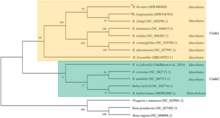| Rubus elegantulus | |
|---|---|
| Scientific classification | |
| Kingdom: | Plantae |
| Clade: | Tracheophytes |
| Clade: | Angiosperms |
| Clade: | Eudicots |
| Clade: | Rosids |
| Order: | Rosales |
| Family: | Rosaceae |
| Genus: | Rubus |
| Species: | R. elegantulus
|
| Binomial name | |
| Rubus elegantulus Blanch. 1906
| |
| Synonyms[1] | |
| |
Rubus elegantulus, the showy blackberry,[2] is an uncommon North American species of flowering plant in the rose family. It grows in the northeastern and north-central United States (from Maine to West Virginia, plus Wisconsin and Minnesota) and eastern Canada (Québec, Newfoundland, and all 3 Maritime Provinces).[3]
Rubus elegantulus is an erect perennial 2–4 feet (30–120 cm) tall, with prickles but no hairs. Leaves are palmately compound with 5 leaflets, slightly darker on the upper surface than on the lower. Fruits are black, nearly spherical.[4]

The genetics of Rubus is extremely complex, so that it is difficult to decide on which groups should be recognized as species. There are many rare species with limited ranges such as this. Further study is suggested to clarify the taxonomy.[6] Some studies have suggested that R. elegantulus may have originated as a hybrid between R. allegheniensis and R. pensilvanicus. [7]
References
- ^ The Plant List, Rubus elegantulus Blanch.
- ^ USDA, NRCS (n.d.). "Rubus elegantulus". The PLANTS Database (plants.usda.gov). Greensboro, North Carolina: National Plant Data Team. Retrieved 25 October 2015.
- ^ Biota of North America Program 2014 county distribution map
- ^ Blanchard, William Henry. 1906. Rhodora 8(89): 95–98
- ^ Park, Young Sang; Park, Jee Young; Kang, Jung Hwa; Lee, Wan Hee; Yang, Tae-Jin (2021-04-03). "Diversity and authentication of Rubus accessions revealed by complete plastid genome and rDNA sequences". Mitochondrial DNA Part B. 6 (4): 1454–1459. doi:10.1080/23802359.2021.1911712. ISSN 2380-2359. PMC 8079122. PMID 33969195.
- ^ Flora of North America, Rubus Linnaeus, 1754. Bramble
- ^ Flora of North America, Rubus pensilvanicus Poiret 1804. Pennsylvania blackberry, ronce de Pennsylvanie
